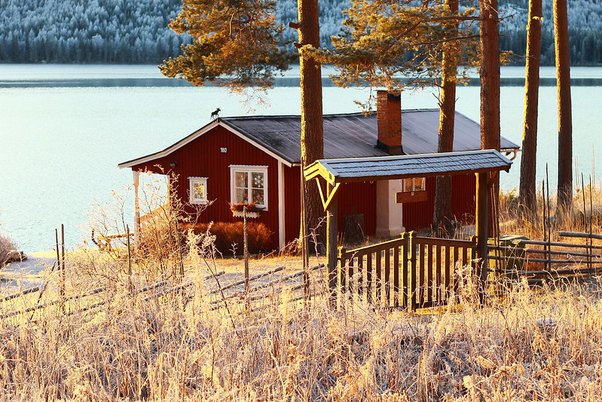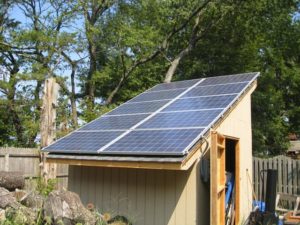As the winter months approach, it’s essential to take steps to protect your off-grid home from the harsh weather conditions that come with this time of year.
Whether you live in a remote cabin or a self-sufficient homestead, these DIY winterizing techniques will help keep you warm and cozy when the temperatures drop.
From insulating your home to crafting unique heating solutions, we’ll dive into practical tips for maintaining a comfortable and sustainable living space all year round.
So grab a cup of tea and let’s get started on these easy-to-follow DIY winterizing techniques!
Insulate Your Home
Proper insulation is key to keeping your home warm and cozy during the winter months. Use materials like foam board, straw, or wool to fill gaps and seal any cracks in your walls, floor, and ceiling.
To start, you’ll need to identify any gaps or cracks in your walls, floor, and ceiling that need to be filled.
For these areas, consider using materials like foam board, straw, or wool.
These materials are not only effective at filling gaps and sealing cracks, but they’re also eco-friendly and can help reduce your energy bills.
When using foam board, look for a type that is specifically designed for insulation and has a high R-value to ensure maximum effectiveness.
For filling cracks and gaps in your walls, straw is an excellent option.
This natural material is not only inexpensive, but it’s also a sustainable and renewable resource.
As for your ceiling, you can use wool to insulate and seal any gaps.
Wool is a great choice because it’s naturally fire-resistant and has excellent sound-absorbing properties.
Regardless of which material you choose, make sure to follow proper installation techniques to ensure a tight seal and optimal insulation performance.
Proper insulation can significantly reduce heat loss, help maintain a consistent indoor temperature, and decrease your energy consumption.
By taking these steps, you’ll not only save money on your energy bills, but you’ll also create a more comfortable and sustainable living space for you and your family.
Seal Your Doors and Windows
Drafts can let cold air in and warm air out, so make sure to seal your doors and windows with caulk or weatherstripping. This will help keep the warm air in and the cold air out.
To effectively insulate your home and keep the warm air in, it’s important to seal your doors and windows.
Drafts can allow cold air to enter and warm air to escape, causing your home to lose its heated air and increasing your energy bills.
By sealing your doors and windows with caulk or weatherstripping, you can prevent these drafts and maintain the warm air inside.
This simple step can make a significant difference in your home’s energy efficiency and comfort level.
Start by examining your doors and windows for any gaps or cracks, then apply caulk or weatherstripping to seal them tightly.
This will not only help keep the warm air in but also prevent cold air from entering, creating a more comfortable and energy-efficient living space.
You can use door draft stoppers or window inserts to further block any drafts and maintain the warm air inside.
By taking this step, you can enjoy a more comfortable and energy-efficient home this winter.
Install Storm Windows
Storm windows can provide an extra layer of protection against cold winds and drafts. They can also help to reduce heat loss through your existing windows.
Installing storm windows can provide an extra layer of protection against cold winds and drafts, as well as help to reduce heat loss through your existing windows.
Storm windows are designed to fit over your existing windows, providing an additional barrier against harsh weather conditions and temperature fluctuations.
This can be particularly beneficial during the winter months, when cold winds and drafts can cause significant heat loss and discomfort.
By installing storm windows, you can help to insulate your home and reduce the amount of heat that escapes through your windows.
Storm windows can help to protect your existing windows from damage caused by wind, rain, and other environmental factors.
With proper installation and maintenance, storm windows can last for many years and provide ongoing energy savings and improved comfort for your home.
Use Window Treatments
Window treatments like curtains or blinds can help to keep your home warm by trapping warm air inside. Choose thick, heavy fabrics like wool or cotton to keep the cold air out.
For an energy-efficient home, utilizing window treatments can be a simple and effective way to keep warm air inside and cold air out.
Choose thick, heavy fabrics like wool or cotton for your curtains or blinds, as these materials provide excellent insulation against harsh temperatures.
During the winter months, close your curtains or blinds during the night to trap warm air inside and prevent cold air from seeping in.
This can help to maintain a cozy and comfortable temperature throughout your home, reducing the need for excessive heating.
Select materials with a tight weave or pattern to further prevent cold air from entering your home.
Not only will this save you money on heating costs, but it will also help to reduce your carbon footprint and contribute to a more sustainable future.
Install a Wood-Burning Stove
A wood-burning stove can be a great way to heat your home during the winter months. Make sure to install it in a well-ventilated area and keep it clean and well-maintained.
Installing a wood-burning stove can be a cost-effective and environmentally friendly solution for heating your home during the winter months.
However, it’s essential to follow proper installation and maintenance practices to ensure safe and efficient operation.
First and foremost, you need to select a well-ventilated area for installing the stove, such as a fireplace or a dedicated wood-burning room.
Proper ventilation is critical to prevent the buildup of carbon monoxide and other harmful gases.
You should also ensure that the stove is installed by a certified professional who can ensure that all safety features and regulations are met.
Once the stove is installed, it’s important to keep it clean and well-maintained.
Regularly cleaning the stove’s glass doors and chimney can help prevent creosote buildup, which can lead to reduced efficiency and increased safety risks.
You should also ensure that the stove is properly loading and burning fuel, as overloaded or unburned fuel can cause issues with the stove’s performance and safety.
To maximize the efficiency and lifespan of your wood-burning stove, it’s important to use dry, seasoned wood and avoid burning treated or painted wood.
You should always use a spark guard to prevent embers from escaping the stove and igniting nearby flammable materials.
Add Passive Solar Design
Consider incorporating passive solar design into your home. This can include large south-facing windows, thermal mass materials, and strategically placed overhangs to capture and store heat from the sun.
Consider incorporating passive solar design into your home to take advantage of the free and renewable energy provided by the sun.
Passive solar design involves strategically placing windows, thermal mass materials, and overhangs to capture and store heat from the sun.
For example, a large south-facing window can allow sunlight to enter and warm the space during the winter, while strategically placed overhangs can provide shade during the summer to reduce heat gain.
Thermal mass materials, such as concrete or brick, can also absorb and store heat, which can then be released back into the space as the temperature drops.
By incorporating passive solar design into your home, you can reduce your reliance on artificial heating and cooling systems, resulting in cost savings and a more sustainable living space.
Passive solar design can improve the natural ventilation of your home, reducing the need for mechanical ventilation and improving indoor air quality.
By implementing passive solar design, you can create a more comfortable and sustainable living space while also reducing your carbon footprint.
Use Radiant Heat
Radiant heat systems can be an effective and efficient way to warm your home. They involve installing heating elements, such as pipes or electric mats, under your floors or in your walls to warm your home from the ground up.
Using radiant heat is an excellent option to warm your home efficiently and effectively.
This innovative technology involves installing heating elements, such as pipes or electric mats, under your floors or in your walls, which then radiate heat to warm your space.
By installing these elements strategically, you can achieve consistent and comfortable temperatures throughout your home without the need for individual space heaters or ductwork.
Plus, radiant heat systems can be tailored to your specific needs and can be integrated with other heating sources, like solar power, to maximize energy efficiency.
The result is a cozy and comfortable living space that’s not only warm but also sustainable and cost-effective.
Consider investing in a radiant heat system to enjoy long-lasting warmth and a healthier, more balanced indoor environment.
Use Body Heat
On cold nights, bundle up and wear warm clothing to bed to trap body heat and keep your home warm. You can also use hot water bottles or heating pads to warm up your bed before climbing in.
On chilly nights, maximize the natural warmth of your body by dressing in layers and using warm bedding.
Wear soft, breathable fabrics like cotton or fleece to keep your skin dry and comfortable.
Avoid synthetic fabrics like polyester, which can retain moisture and make you feel colder.
Consider using a hot water bottle or heating pad on your bed before climbing in to warm up the mattress and trap body heat.
You can also use a heated mattress pad or electric blanket to keep your bed warm throughout the night.
For an extra cozy touch, place a few hot stones or a heated bean bag in your bed to radiate warmth and soothe your body.
By utilizing your body heat, you can create a toasty sleep environment that promotes better sleep and wakes you up feeling refreshed and energized.
Want More? Dive Deeper Here!
Hey there! If you’re the type who loves going down the rabbit hole of information (like we do), you’re in the right spot. We’ve pulled together some cool reads and resources that dive a bit deeper into the stuff we chat about on our site. Whether you’re just killing time or super into the topic, these picks might just be what you’re looking for. Happy reading!






